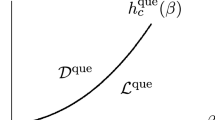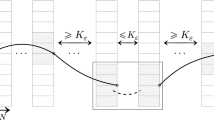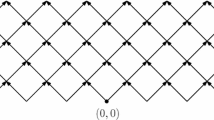Abstract
We study the critical point of directed pinning/wetting models with quenched disorder. The distribution K(·) of the location of the first contact of the (free) polymer with the defect line is assumed to be of the form K(n) = n −α-1 L(n), with α ≥ 0 and L(·) slowly varying. The model undergoes a (de)-localization phase transition: the free energy (per unit length) is zero in the delocalized phase and positive in the localized phase. For α < 1/2 disorder is irrelevant: quenched and annealed critical points coincide for small disorder, as well as quenched and annealed critical exponents [3,28]. The same has been proven also for α = 1/2, but under the assumption that L(·) diverges sufficiently fast at infinity, a hypothesis that is not satisfied in the (1 + 1)-dimensional wetting model considered in [12,17], where L(·) is asymptotically constant. Here we prove that, if 1/2 < α < 1 or α > 1, then quenched and annealed critical points differ whenever disorder is present, and we give the scaling form of their difference for small disorder. In agreement with the so-called Harris criterion, disorder is therefore relevant in this case. In the marginal case α = 1/2, under the assumption that L(·) vanishes sufficiently fast at infinity, we prove that the difference between quenched and annealed critical points, which is smaller than any power of the disorder strength, is positive: disorder is marginally relevant. Again, the case considered in [12,17] is out of our analysis and remains open.
The results are achieved by setting the parameters of the model so that the annealed system is localized, but close to criticality, and by first considering a quenched system of size that does not exceed the correlation length of the annealed model. In such a regime we can show that the expectation of the partition function raised to a suitably chosen power \({\gamma \in (0, 1)}\) is small. We then exploit such an information to prove that the expectation of the same fractional power of the partition function goes to zero with the size of the system, a fact that immediately entails that the quenched system is delocalized.
Similar content being viewed by others
References
Aizenman M., Molchanov S.: Localization at large disorder and at extreme energies: an elementary derivation. Commun. Math. Phys. 157, 245–278 (1993)
Aizenman M., Schenker J.H., Friedrich R.M., Hundertmark D.: Finite-volume fractional-moment criteria for Anderson localization. Commun. Math. Phys. 224, 219–253 (2001)
Alexander K.S.: The effect of disorder on polymer depinning transitions. Commun. Math. Phys. 279, 117–146 (2008)
Alexander K.S., Sidoravicius V.: Pinning of polymers and interfaces by random potentials. Ann. Appl. Probab. 16, 636–669 (2006)
Alexander, K.S., Zygouras, N.: Quenched and annealed critical points in polymer pinning models. http://arxiv.org/abs0805.1708V1[math.PR], 2008
Bingham N.H., Goldie C.M., Teugels J.L.: Regular variation. Cambridge University Press, Cambridge (1987)
Birkner, M., Sun, R.: Annealed vs quenched critical points for a random walk pinning model. http://arxiv.org/abs:0807.2752V1[math.PR], 2008
Bolthausen, E., Caravenna, F., de Tilière, B.: The quenched critical point of a diluted disordered polymer model. Stochastic Process. Appl. (to appear), http://arxiv.org/abs/0711.0141V2[math.PR], 2007
Buffet E., Patrick A., Pulé J.V.: Directed polymers on trees: a martingale approach. J. Phys. A Math. Gen. 26, 1823–1834 (1993)
Chayes J.T., Chayes L., Fisher D.S., Spencer T.: Finite-size scaling and correlation lengths for disordered systems. Phys. Rev. Lett. 57, 2999–3002 (1986)
Coluzzi B., Yeramian E.: Numerical evidence for relevance of disorder in a Poland-Scheraga DNA denaturation model with self-avoidance: Scaling behavior of average quantities. Eur. Phys. J. B 56, 349–365 (2007)
Derrida B., Hakim V., Vannimenus J.: Effect of disorder on two-dimensional wetting. J. Stat. Phys. 66, 1189–1213 (1992)
Doney R.A.: One-sided local large deviation and renewal theorems in the case of infinite mean. Probab. Theory Rel. Fields 107, 451–465 (1997)
von Dreifus H.: Bounds on the critical exponents of disordered ferromagnetic models. Ann. Inst. H. Poincaré Phys. Théor. 55, 657–669 (1991)
Evans M.R., Derrida B.: Improved bounds for the transition temperature of directed polymers in a finite-dimensional random medium. J. Stat. Phys. 69, 427–437 (1992)
Fisher M.E.: Walks, walls, wetting, and melting. J. Stat. Phys. 34, 667–729 (1984)
Forgacs G., Luck J.M., Nieuwenhuizen Th.M., Orland H.: Wetting of a disordered substrate: exact critical behavior in two dimensions. Phys. Rev. Lett. 57, 2184–2187 (1986)
Gangardt D.M., Nechaev S.K.: Wetting transition on a one-dimensional disorder. J. Stat. Phys. 130, 483–502 (2008)
Garsia A., Lamperti J.: A discrete renewal theorem with infinite mean. Comment. Math. Helv. 37, 221–234 (1963)
Giacomin G.: Random Polymer Models. Imperial College Press/World Scientific, River Edge, NJ (2007)
Giacomin, G., Lacoin, H., Toninelli, F.L.: Hierarchical pinning models, quadratic maps and quenched disorder. Probab. Theory Rel. Fields (to appear), http://arxiv.org/abs/0711.4649V2[math.PR], 2007
Giacomin, G., Lacoin, H., Toninelli, F.L.: Marginal relevance of disorder for pinning models. http://arxiv.org/abs/0811.0723V1[math-ph], 2008
Giacomin G., Toninelli F.L.: Estimates on path delocalization for copolymers at selective interfaces. Probab. Theor. Rel. Fields 133, 464–482 (2005)
Giacomin G., Toninelli F.L.: Smoothing effect of quenched disorder on polymer depinning transitions. Commun. Math. Phys. 266, 1–16 (2006)
Giacomin, G., Toninelli, F.L.: On the irrelevant disorder regime of pinning models. preprint (2007). http://arxiv.org/abs/0707.3340V1[math.PR]
Harris A.B.: Effect of Random Defects on the Critical Behaviour of Ising Models. J. Phys. C 7, 1671–1692 (1974)
Kafri Y., Mukamel D., Peliti L.: Why is the DNA denaturation transition first order?. Phys. Rev. Lett. 85, 4988–4991 (2000)
Toninelli F.L.: A replica-coupling approach to disordered pinning models. Commun. Math. Phys. 280, 389–401 (2008)
Toninelli F.L.: Disordered pinning models and copolymers: beyond annealed bounds. Ann. Appl. Probab. 18, 1569–1587 (2008)
Author information
Authors and Affiliations
Corresponding author
Additional information
Communicated by M. Aizenman
Rights and permissions
About this article
Cite this article
Derrida, B., Giacomin, G., Lacoin, H. et al. Fractional Moment Bounds and Disorder Relevance for Pinning Models. Commun. Math. Phys. 287, 867–887 (2009). https://doi.org/10.1007/s00220-009-0737-0
Received:
Accepted:
Published:
Issue Date:
DOI: https://doi.org/10.1007/s00220-009-0737-0




